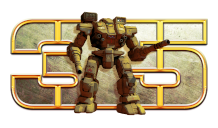- Home
- New To BattleTech?
- MUL
- Forums
- News
- Books
- Shrapnel
- Universe
- Downloads
- Characters
- Community
- Errata
- Links
- Gallery
Handbook: House Kurita Art Notes: The Process Part 2
On January 10, 2014
As mentioned in the previous BattleBlog, we’re working on the art for Handbook: House Kurita. Additionally, I Tumblr about dissecting the Handbook covers determining how to build this cover.
Here’s the art notes that I generated and passed to Brent for review and to pass along to the artist.
>>>>>>>>>>>>
HOUSE KURITA COVER ART NOTES:
This will follow the same format as the previous Handbooks, with a mosaic of four images centered around the House Kurita logo.
Each illustration should be 3.863 inches width and 4.2 inches height at 300 dpi so they fit the established dimensions for our Handbook covers.
All references are in the “House Kurita Cover” folder in the “Handbook: House Kurita” folder on the ftp site.
PANEL ONE (BattleMech)
1) A No-Dachi BattleMech, sporting the colors of the Fifth Sword of Light, is participating in a live-fire training course of the Kensai Kamai weapons master program.
There should be a Kensai Kami flag somewhere (perhaps planted on a hill or flying above a fortification/pill box or some such). The insignia has the following description:
-
Kensai Kami colors are red, black and gold. The insignia is the black silhouette of a Hatamoto-Chi wreathed in red energy bolts, set against a golden field.
Art Note: The following link provides photo reference for the No-Dachi:
http://camospecs.com/Miniature.asp?ID=3146
Art Note: The following link provides photo reference for the Fifth Sword of Light paint scheme: http://camospecs.com/Miniature.asp?ID=5986
Art Note: The following link provides photo reference for the Hatamoto-Chi mentioned above in the Kentai Kami insignia: http://camospecs.com/Miniature.asp?ID=3147
PANEL TWO (Nobility)
Coordinator Theodore Kurita in full regalia meets in the Black Room with the four Warlords of the Draconis Combine, also all in their full uniforms.
Tai-shu Isoroku Kurita: Warlord of Dieron
Tai-shu Li Dok To: Warlord of Galedon
Tai-shu Boris Petroff: Warlord of Benjamin
Tai-shu Teyasu Ashora: Warlord of Pesht
No description is provided of the Black Room, but it is an ultra secure room for the most important meeting in the entire empire. The “Black” could be part of the décor, not just a description of its “black out” nature. Let the artist create something both military-futuristic but very Combine at the same time, and also feels like it would take a regiment to breach.
The key aspect of the scene is to have Theodore leaning back, looking over steepled fingers, watching the standing Warlords trying to shout each other down. How all Coordinators have kept the sprawling, military-run star empire from collapsing under Warlords trying for the throne…the Coordinator carefully maneuvers them so they’re constantly worried at each other and not eying him.
PANEL THREE (Flavor of a Faction)
This illustration should depict the Sanctum Arcanum; the full description of this locale is found below (taken directly from this sourcebook):
-
Five symbolic pillars are said to support the society of House Kurita: the Pillar of Gold, signifying the ruling Kurita dynasty and its governing apparatus; the Pillar of Steel, symbolizing the military; the Pillar of Jade, representing the economic productivity and the flow of wealth and commerce; the Pillar of Teak, standing for the culture and art of the Combine; and the Pillar of Ivory, exemplifying faith, philosophy, and codes of conduct.
Deep within the recesses of Unity Palace on Luthien is a complex of small apartments called the Sanctum Arcanum. The innermost room is a low-ceilinged chamber dimly lit by indirect lights. Most of the chamber is taken up by a raised platform covered with an ancient, richly colored carpet woven with the design of an intricate Asiatic dragon. In the center of the rug is a black-lacquered sword stand holding the well-worn katana of the dynastic founder, Lord Shiro Kurita. The figure of the dragon twines around five columns that rise from platform to ceiling. Each pillar, standing in a collar of filigreed gold at the base, is carved from a different kind of ivory.
To the right of the sword stand is a smooth, cream-colored column of soft ivory, a huge elephant tusk from the eastern coast of Africa on Terra. Its strength is self-evident, but its relative softness, which makes it the easiest for ivory carvers to work, is symbolic of the adaptability of Kurita doctrine within its basic shape. To the left of the stand is a column that looks like clear glass but is actually a gigantic fire hippopotamus tusk from the tropical world of Thimphu. It is extremely dense, hard ivory—so hard it gives off fire when struck with steel. It symbolizes the strength and rigor of the unbending Kurita codes.
Slightly behind the sword stand and to the right is a column of vivid turquoise. This is also the shaft of a single tusk from an ancient mammoth recovered from deep within the Siberian tundra on Terra. During the tens of thousands of years the tusk was buried, the metallic salts that gave it its color slowly penetrated the tusk’s pores. This mammoth tusk is symbolic of the deep roots that Kurita ideology has in the ancient doctrines of Terran Asia.
Behind and to the left of the sword stand sits a rough-looking ivory column that is streaked and unevenly colored but nonetheless massive in its strength. Unfinished, with the bark still on, this tusk came from the same elephant as the soft ivory pillar in the front. It symbolizes the Kuritan people, rough and unfinished themselves, needing the hand of the artisan but at heart willing to be shaped.
Directly behind the sword is the last ivory column, carved into the serpentine body of an Asian dragon twisting into a left-handed spiral. Another fossil, the pillar was made from the single, sword-like horn of the extinct monodon, once native to the ancient seas of the arctic wastes of Labrea. Until it was uncovered during a twenty-seventh century mining operation, this huge trunk of ivory had spent millennia buried in the permafrost, leaching radioactive isotopes. When the lights in the Sanctum Arcanum are turned off, this fifth pillar seems to hang in the air like a glowing dragon, filling the chamber with its own soft illumination.
The figure of the Dragon pervades and sums up much of Kurita mythology. At times, it is taken to mean the First Lord, Shiro Kurita. At other times, it stands for the entire Draconis Combine. The fifth pillar symbolizes the sea and the land, the past and the present, the people and the society, all united in the body of the Dragon of House Kurita.
Built into the floor directly in front of the platform in the Sanctum Arcanum is a section of straw tatami mats covered with tightly stretched, brilliantly clean white canvas. Of the same length as the room—just under five meters—and one meter wide, this area resembles a miniature judo or aikido practice mat. At each end of the mats, two hooded figures sit on their heels, facing each other at attention. With hands on knees, they remain perfectly still but always alert. Each wears a wide-sleeved robe of rough brown cloth. What appear to be starched linen wings cover their throats and shoulders, but the material is actually a flexible ceramic that is impervious to weapons. The figures’ heads are hooded, and darkly tinted shields obscure all but the lower part of their faces. Blue, metallic-looking sashes tied around their waists hold their robes shut. These monkish guards are Adepts of the Order of the Five Pillars (O5P).
PANEL FOUR (Unique “Element”)
This should be a seppuku ceremony just as it’s about to get underway.
There’s a fantastic illustration that captures this event and the artist should use that reference to create his own take on it.
However, the unique angle to add here is a DEST trooper (or more) standing guard in the background; i.e. this is a “forced” retirement from the military, done in only the way the Combine does it.
Randall







